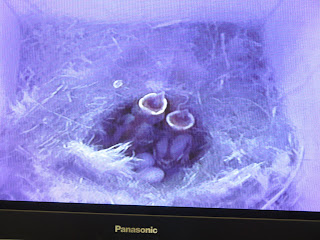The Swanage Railway in Dorset is a volunteer-run service taking passengers from the seaside town of Swanage, north through the Purbeck Hills and almost as far as Wareham at the mouth of the River Frome.
The railway was initially closed by the 1960`s Beeching Cuts but has been reopened and restored in recent years. The sight of one of its steam locomotives puffing through the Purbeck Hills is nostalgic, always exciting and a testament to the hard work of the many keen men and women who have strived to restore the railway. More information is on www.swanagerailway.co.uk
For four days in early May, 2016, Swanage Railway held a Diesel Gala and Beer Festival, which attracted enthusiasts from all over the country. Restored diesel engines took over the work of the usual steam locomotives and pulled carriages up and down the line from Swanage. They reportedly carried over 4,000 passengers during the Gala.
The blue engine above and below was being used for a "Train Driving Experience" and Mr DW was lucky enough to have been given this experience for his birthday. We set off early from the New Forest and drove westwards to the Purbecks on a sunny Saturday. At Norden Station, near Corfe Castle, Mr DW and our elder son climbed aboard and enjoyed a wonderful morning learning to drive the train, on the up-line from Norden to just south of Wareham where the track now ends.
Below, they are setting off, under the road bridge and away!
While they were busy "playing trains", I walked up towards the main station with our daughter-in-law and the Slate Grey Dog, who was about to experience something completely new and exciting.
Trees along the pathway were coming into leaf and wild flowers were everywhere.
From the railway platform, we looked across at the signal box, and old green carriage, all lovingly restored.
A diesel passed through the station and the Slate Grey Dog was quite unruffled by the noise and unfamiliar smells.
Another engine, the Ark Royal, passed by.
Past cattle trucks and station buildings, we found a short path that led to a siding where trucks and a small engine rested.
This little train once carried clay from Purbeck quarries to the local potteries. The Purbecks have a history of water and sewage pipe manufacture and clay smoking pipe production. It is hard to dig in a local cottage garden without discovering broken stems of old clay pipes that were smoked by previous inhabitants.
We found a grassed-over bridge that spanned the railway line just south of Norden Station. We sat down to enjoy the warm day and the view across fields to ruined Corfe Castle beyond. Grass banks and hedgerows were studded with bluebells and their scent filled the morning air.
Another well-loved and freshly painted diesel snaked into view, passing the Castle and whistling as directed by the green sign.
People embarked from the short platform, the train moved on and peace returned.
Another train came around the corner......
....and whistled on cue.
We waited until Mr DW and Son appeared, smiling broadly at the end of their train driving time.
A few more diesels came and went. A great many happy enthusiasts poured on and off the platform, in and out of the old green carriages that hauled them through hills and meadows, down towards the sea and the beer at Swanage.
We wandered back through the trees to find a shady place beside a bluebell wood, where a picnic lunch restored us for an afternoon walk with the dogs across heathland near Wareham, a few miles to the north.






































